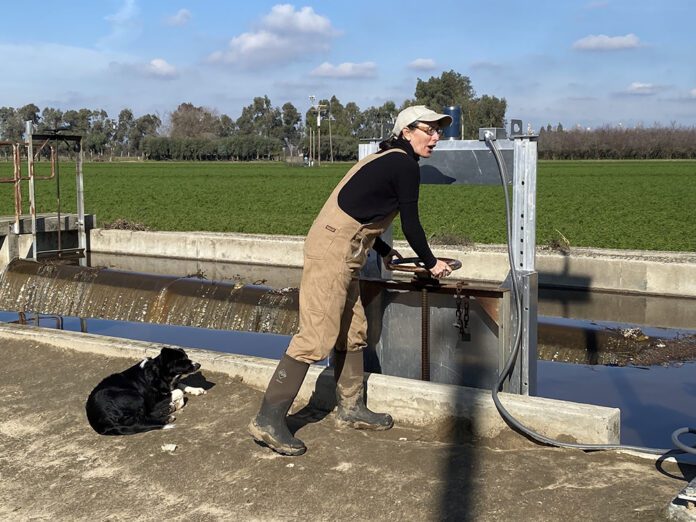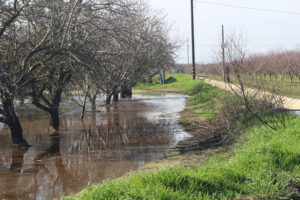
Thanks to two wet years in a row, irrigation districts and individual growers have taken advantage of available surface water to recharge underground aquifers.
Their efforts are very geographically dependent, said Joe Choperena, project director of water resources for Sustainable Conservation, an industry group focused on recharge. In northern San Joaquin Valley counties, and in irrigation districts with senior water rights where surface water is more abundant, growers are taking water from canals and flooding orchards and fields.
Farther south, less surface water is available for this, but incentives allowing growers to increase groundwater pumping allocations are driving more recharge.
Choperena said in areas of the valley where aquifers are critically over drafted due to excess groundwater pumping, incentives are in place to encourage more recharge projects. Some groundwater sustainability agencies are offering credits for limiting pumping.
Recharge of water occurs in several ways: rainfall or seepage from waterways, flood irrigation of crops and intentional or managed aquifer recharge, noting the rate and environmental limitations. The vadose zone, the area of the soil below the crops’ root zone to the top of the groundwater table, controls water movement and affects recharge rates.
Variability in subsurface soil and sediment texture can affect where the recharged water will flow to the groundwater table.
Canal Water Delivery
Almond growers Christine and Erich Gemperle in the Ceres area decided in 2023 to take some of the canal water adjacent to their orchards to recharge.
“Turlock Irrigation District offered to increase allocations as part of their flood risk reduction efforts,” Christine Gemperle said. “After three years of zero allotment, we took them up on it.”
The Gemperles were part of a pilot study that took gravity flow water and applied it to dormant almond orchards. The orchards are set up with one turnout per five acres. The district also installed Rubicon Flume meters to measure water.
Gemperle said little field prep was necessary. The three blocks taking the water were rated moderately good for recharge, and no additional groundwork was necessary to hold the water. The blocks were flooded three times in a two-week period, and even during rainy periods there was no standing water in the orchards after 12 hours. Cover crops aided with the water infiltration, Gemperle said.
Choperena said two other growers in the district took advantage of the on-farm recharge pilot program at TID. Labor to monitor the recharge events was the only cost. Water applied in January was 27.5 acre-feet. In February 16.5 acre-feet was applied.
Gemperle said there were initial concerns about losing trees to blow down or disease after flooding, but orchard health and production were good in 2023.
“There was actually improvement as the flooding flushed the salts that had been building after using groundwater to supplement irrigation during the drought,” she said.
She said the opportunity for more water came this February and after some juggling with bee sites the blocks were flooded. Again, there was little issue with standing water and infiltration.
Sustainable Conservation recharge case studies included a Madera County site where 165 acres of almonds were flooded with water provided by Chowchilla Water District at $10 an acre-foot. Owner Karun Samran had spread compost on berms postharvest and applied shredded prunings and planted a cover crop.
The original gravity flood irrigation infrastructure was intact, and no additional work was necessary. In this project, 10 rows were flooded at one time. Once 3 to 4 inches of water covered those rows, the process was repeated on the next 10 rows. Total water recharged from January 13 to February 6 was 172.6 acre-feet over 165 acres.
Individuals taking flood water to recharge are one part of the recharge effort. Recharge basins constructed by irrigation districts or individuals in the San Joaquin Valley lead the way in total volume of water stored underground.
Dedicated Basins Outperform
Choperena said Madera Irrigation District did more recharge on their fields than all their other dedicated basins combined, noting overall basins typically outperform on-farm recharge totals.
Rogelio Caudillo, manager of the Eastern Tule Groundwater Sustainability Agency, said from 2021 to present, a total of 33,600 acre-feet of water were used to recharge in the groundwater basin under his agency. Caudillo said most of the recharge was done by local irrigation districts.
He said irrigation districts with access to excess surface water are at the forefront of the recharge effort. Districts are investing in infrastructure projects that recharge ground water with hopes to restore balance with pumping.
Public Policy Institute of California, in a report on replenishing groundwater in the San Joaquin Valley, notes recharge water is mainly available over a short period of time during high-flow events. A central issue is the capacity to move more water from the wetter northern half of the valley to the drier southern half, where overdraft is more pronounced and recharge conditions are more favorable.

This has been made more difficult as conveyance capacity has been reduced due to land subsidence around the Friant-Kern Canal. Expanding recharge will also require local, state and federal entities to address a range of regulatory and institutional barriers for recharge.
Research conducted at California State University, Fresno resulted in the analysis of a technique to allow groundwater recharge under existing crops. The Shallow Subsurface Artificial Groundwater Recharge (SSAGR) system takes rechange water from a canal to a pump where it is lifted into a standpipe and then distributed to perforated pipelines (tile drainpipes) buried below the crop root zone. These systems were developed prior to the Fresno State project, and there are about 30 installed in the San Joaquin Valley.
FSU Analysis
At the research site at Fresno State, installation of the SSAGR underground pipeline system occurred prior to planting almond trees to allow for maximum access to the site by the equipment. The system can be installed in existing orchards but would require specialized machinery and time due to access restrictions. Installation of the system in 2020 was valued at $38,000.
The report on the SSAGR system said that 1,204 hours of recharge were accomplished during June, July and August 2022. One benefit of these systems is growers can recharge orchards during the growing season without interrupting their management practices.
The SSAGR system was operating 55% of the time during those months. The recharge rate was 361 cubic ft per hour or 16.1 ft per hour based on a total area of 0.50 acres. 100% of the applied water became recharged water. Moisture probe data indicated that the recharged water moved down and probably horizontally, which means it was not retained in the vadose zone and eventually reached the aquifer.
Results from the research showed this technology can recharge 100% of the water input, an improvement of efficiency over a recharge basin which has losses to evaporation. An important aspect is the placement of the pipelines below the root zone, meaning fertilizers will not be flushed into the groundwater table.










